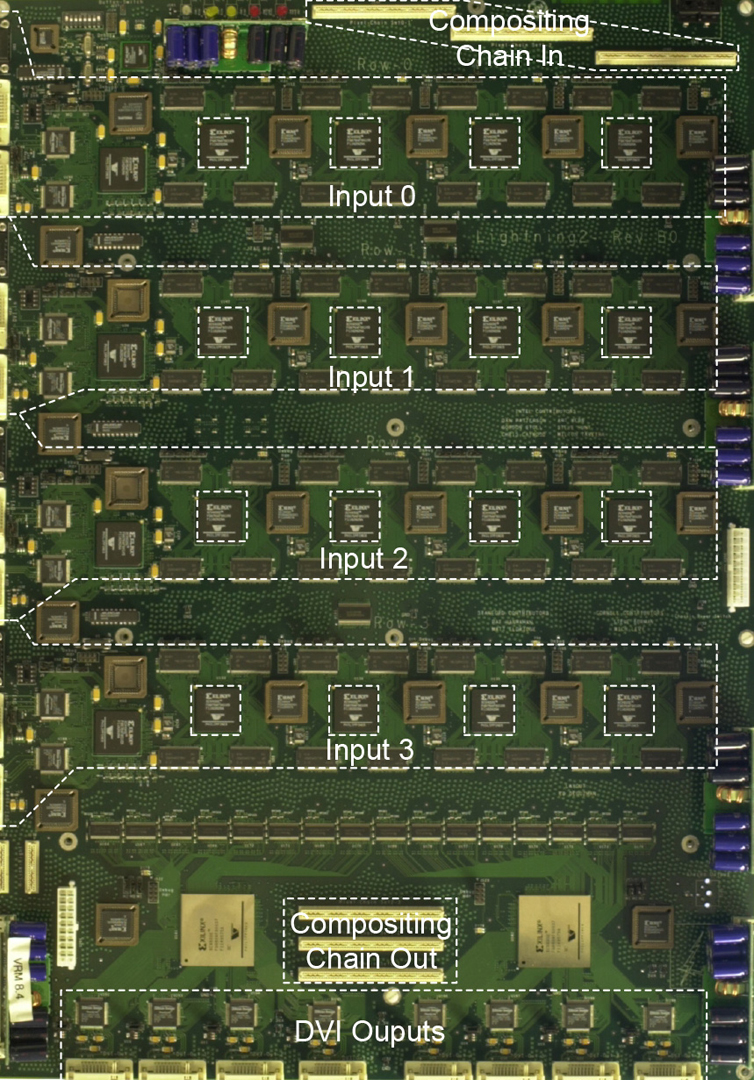“Lightning-2: a high-performance display subsystem for PC clusters” by Stoll, Eldridge, Patterson, Webb, Berman, et al. …
Conference:
Type(s):
Title:
- Lightning-2: a high-performance display subsystem for PC clusters
Presenter(s)/Author(s):
Abstract:
Clusters of PCs are increasingly popular as cost-effective platforms for supercomputer-class applications. Given recent performance improvements in graphics accelerators, clusters are similarly attractive for demanding graphics applications. We describe the design and implementation of Lightning-2, a display subsystem for such a cluster. The system scales in both the number of rendering nodes and the number of displays supported, and allows any pixel data generated from any node to be dynamically mapped to any location on any display. A number of image-compositing functions are supported, including color-keying and depth-compositing. A distinguishing feature of the system is its platform independence: it connects to graphics accelerators via an industry-standard digital video port and requires no modifications to accelerator hardware or device drivers. As a result, rendering clusters that utilize Lightning-2 can be upgraded across multiple generations of graphics accelerators with little effort. We demonstrate a renderer that achieves 106 Mtri/s on an 8-node cluster using Lightning-2 to perform sort-last depth compositing.
References:
1. William Blank, Chandrajit Bajaj, Donald Fussel, and Xiaoyu Zhang. The MetaBuffer: A Scalable Multiresolution Multidisplay 3-D Graphics System Using Commodity Rendering Engines. Technical Report TR2000-16, Department of Computer Science, University of Texas at Austin, 2000.
2. Ross Cunniff. Visualize fx Graphics Scalable Architecture. In Proceedings of Eurographics Hardware/SIGGRAPH Hot3D, pages 29- 38, August 2000.
3. Tom Duff. Compositing 3-D Rendered Images. Computer Graphics (Proceedings of SIGGRAPH 85), pages 41-44, July 1985.
4. Matthew Eldridge and John D. Owens. Lightning: A Scalable, Distributed, Virtual Framebuffer. Technical Report (Unpublished), Department of Electrical Engineering, Stanford University, 1998.
5. Digital Display Working Group. Digital Visual Interface 1.0 Specification, 1999. http://www.ddwg.org.
6. Alan Heirich and Laurent Moll. Scalable Distributed Visualization Using Off-the-Shelf Components. Symposium on Parallel Visualization and Graphics, pages 55-60, October 1999.
7. Greg Humphreys, Matthew Eldridge, Ian Buck, Gordon Stoll, Matthew Everett, and Pat Hanrahan. WireGL: A Scalable Graphics System for Clusters. Computer Graphics (Proceedings of SIGGRAPH 01), August 2001.
8. Steven Molnar, Michael Cox, David Ellsworth, and Henry Fuchs. A Sorting Classification of Parallel Rendering. IEEE Computer Graphics and Applications, pages 23-32, July 1994.
9. Steven Molnar, John Eyles, and John Poulton. PixelFlow: High-speed Rendering Using Image Composition. Computer Graphics (Proceedings of SIGGRAPH 92), pages 231-240, July 1992.
10. Steven Molnar and Henry Fuchs. Advanced Raster Graphics Architecture, chapter 18, pages 899-900. Addison-Wesley, second edition, 1990.
11. K. R. Schleupen. Driving and Interface Technology for High Resolution AM-LCDs. Seventh International Display Workshops (Proceedings of IDW 00), November 2000.
12. T. Ueki. Requirements for Large Size and High Resolution TFT-LCDs. Proceedings of the International Display Manufacturing Conference, 2000.





